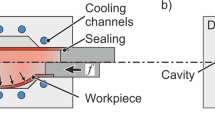Abstract
Fluid systems in a variety of industries use tube fittings to readily install leak-free connections. Robust tube-fitting performance depends on adequate differential hardness, the gripping element on the tube, and a guided plastic deformation of the tube-gripping components. Low-temperature carburization technology hardens the surface of austenitic stainless steels. Since 1999, this treatment has been applied to the ferrules of the Swagelok tube fitting, ensuring tube grip, gas-tight seal, and vibration resistance in hundreds of millions of fluid system connections around the world. The process involves activation of the surface followed by a gas-phase treatment, performed at temperatures low enough to avoid the formation of carbides, for a sufficient time to allow carbon diffusion to occur. The result is a hardened conformal case on the treated parts without distortion or change to dimension. The treated case remains austenite (with verified carbon concentrations over 12 atomic percent at the surface) and retains its ductility. This paper will discuss the design features and performance characteristics of tube fittings enabled by low-temperature carburization.
Similar content being viewed by others
References
B.H. Kolster, “Wear and Corrosion Resistant Coatings on Austenitic Steels,” VDI-Berichte (Assn. of German Eng.), Rep. 506 (1983), pp. 1–17, translation.
U. Gramberg et al., “Improvement of the Vibratory Fatigue Limit and of the Corrosion and Wear Resistance through Selectively Targeted Surface Treatments,” VDI-Berichte (Assn. of German Eng.), Rep. 506 (1983), pp. 1–13, translation.
D.B. Lewis et al., “Metallurgical Study of Low-Temperature Plasma Carbon Diffusion Treatments for Stainless Steels,” Surface and Coating Technology, 60(1–3) (1993), pp. 416–423.
P. Stevenson et al., “The Effect of Process Parameters on the Plasma Carbon Diffusion Treatment of Stainless Steels at Low Pressure,” Surface and Coating Technology, 63(3) (1994), pp. 135–143.
Y. Ihara et al., “The Corrosion Behavior of Chromium in Hydrogen Chloride Gas and Gas Mixtures of Hydrogen Chloride and Oxygen at High Temperatures,” Corrosion Science, 23(2) (1983), pp. 167–181.
J.P. Millet et al., “Corrosion Behavior of 316L Stainless Steel in a Chloride Medium in Contact with Active Carbon,” NACE Conference Proceedings (Houston, TX: NACE, 1988), pp. 45–53.
P.C. Williams and S.V. Marx, “Low Temperature Case Hardening Processes,” U.S. patent 6,093,303 (25 July 2000).
P.C. Williams and S.V. Marx, “Selective Case Hardening Processes at Low Temperature,” U.S. patent 6,165,597 (26 December 2000).
P.C. Williams and S.V. Marx, “Low Temperature Case Hardening Processes,“ U.S. patent 6,461,448 (8 October 2002).
P.C. Williams and S.V. Marx, “Modified Low Temperature Case Hardening Processes,” U.S. patent 6,547,888 (15 April 2003).
B. Weiss and R. Sticker, “Phase Instabilities during High Temperature Exposure of 316 Austenitic Stainless Steel,“ Metallurgical Transactions A, 3(4) (1972), pp. 851–866.
Y. Cao, “Surface Hardening of Austenitic Stainless Steels via Low-temperature Colossal Supersaturation” (Ph.D. thesis, Case Western Reserve University, 2003).
Y. Cao, F. Ernst, and G.M. Michal, “Colossal Carbon Supersaturation in Austenitic Stainless Steels Carburized at Low Temperature,” Acta Materialia, 51 (2003), p. 4171.
G.M. Michal et al., “Carbon Supersaturation Due to Paraequilibrium Carburization: Stainless Steels with Greatly Improved Mechanical Properties,” Acta Materialia, 54 (2006), p. 1597.
G.M. Michal, F. Ernst, and A.H. Heuer, “Carbon Paraequilibrium in Austenitic Stainless Steel,” Metall. Mater. Trans. A, 36 (2006), pp. 1819–1824.
Author information
Authors and Affiliations
Corresponding author
Rights and permissions
About this article
Cite this article
Williams, P.C., Collins, S.R. Mechanical design using low-temperature carburization. JOM 60, 27–30 (2008). https://doi.org/10.1007/s11837-008-0161-5
Published:
Issue Date:
DOI: https://doi.org/10.1007/s11837-008-0161-5




